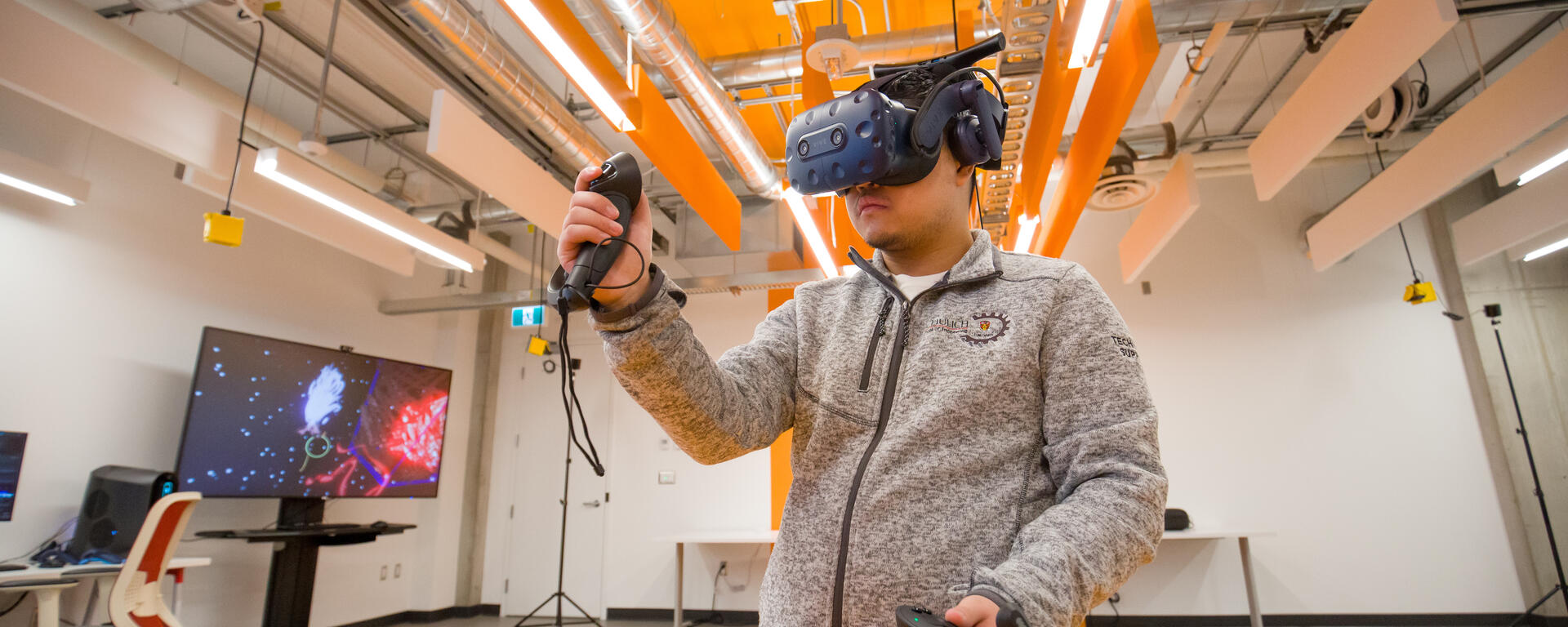Program Overview
With the expansion of infrastructures and advanced digital learning technologies, there is an ongoing evolution to support greater personalized learning experiences within technology-enhanced learning environments in K-12, higher education, and in the workplace learning. With the advances in immersive technologies, educators need to design robust learning experiences within augmented, mixed and virtual reality environments. Immersive learning provides the opportunity for students to transcend physical barriers and to experience learning that may not be possible within the traditional classroom. Within this certificate, students will have the opportunity to develop an understanding of and experience in immersive learning, as well as to engage in designing, developing, and assessing immersive learning environments.
Program Details
Goals:
- To explore various forms of immersive learning environments that can be integrated into K-12, higher education and workplace learning environments (e.g., augmented, mixed- and virtual reality).
- To design and develop an immersive learning environment or unit of study that integrates immersive technology for K-12, higher education or workplace learning environments.
- To assess learning within immersive learning environments designed and/or used by students in the certificate.
Experiential learning is learning by doing that bridges knowledge and experience through critical reflection. This program offers the following kinds of experiential learning opportunities:
- Designing and developing immersive learning environments: Students will explore and create immersive experiences using augmented-, mixed-, and virtual-reality, tailored to K-12, higher education, or workplace learning environments.
- Assessing immersive learning environments: Students will assess the effectiveness of immersive learning environments they design, gaining insights into learner engagement, knowledge transfer, and real-world application.
- Reflecting on immersive learning practices: Throughout the certificate, students will think critically about their experiences with immersive technologies, considering how these tools impact learning and how they can be applied in different educational settings.
Educators have a greater selection of technology to integrate in their teaching and learning with the evolution of digital and immersive technologies. With the advancements in immersive technologies, students are able to engage in augmented and virtual learning environment at the desktop and are not required to be in a virtual reality lab. With more emphasis on experiential learning, the affordances of immersive technologies can provide various opportunities for students to experience learning that may not otherwise occur in the classroom. It may assist in competency development such as cognitive flexibility, problem solving, creative thinking, etc.
Reviewing the trends in technology literature, immersive learning is a growing area. With the evolution of digital technologies, we are observing virtual reality moving onto our desktops, as opposed to fixed lab environments. Through these learning environments, students have greater opportunity to experience learning.
A registration package will be sent to new students after they have been admitted. Registration for the summer term will be available in late winter. Fall and Winter registration opens in the spring. Your Graduate Program Administrator will send more information about registration to you.
Fee details are available through the University Calendar. An explanation of fees is available on the Faculty of Graduate Studies' website.
The University of Calgary offers multiple ways to meet the cost of your education. Please refer to the Awards, Scholarships and Bursaries page to learn more about options available to students. For additional information, please contact Student Financial Support.
Program Schedule & Course Descriptions
- Program begins each July (summer term 1)
- Outlines are normally available 1-2 weeks prior to the start of term in D2L
- 3 units per course
Term 1 - Summer
Introduction to Immersive Learning (On campus)
The purpose of this course is to introduce students to immersive learning in K-12, higher education, and workplace learning environments. Students will examine various types of technologies being used for immersive learning experiences. They will explore current trends of immersive learning and the impact it is having on student learning. Further, the following topics will be addressed: accessibility, inclusion, equity, humanity, safety, privacy, sustainability, and wellness. Students will be introduced to designing for emergent learning and issues in immersive learning.
Term 1 - Summer
Immersive Learning Technologies (On campus)
In this course, students will explore various immersive learning environments and types of technologies. As part of this exploration, students will explore generative artificial intelligence (AI) tools for co-creating images, videos, audio, 3D models, etc. that can be used in immersive learning. Students will engage with and experience multiple immersive learning environments and examine how they are being used within various contexts and disciplinary areas. Further, students will examine learning design principles for the students’ creation of an immersive learning environment.
Term 2 - Fall
Developing Immersive Learning (Online)
Drawing on the design plan from the Immersive Learning Technologies course (EDER 6XX), students will develop an immersive learning environment focused on a topic within their field and using a particular technological platform (e.g., augment reality, virtual reality, simulation) or design a unit of study that integrates a selected immersive technology. An iterative design process of integrated feedback loops will be used to help inform the development. Students will journal the development process and provide critical reflection and peer feedback.
Term 3 - Winter
Evaluating Immersive Learning (Online)
The focus of this course is on the assessment, evaluation, and advancement of effective immersive learning. Assessment criteria will be developed and applied in assessing the immersive learning environments created and/or used in the EDER 6XX: Immersive Learning Environment Development course. Peer feedback from colleagues will then be reviewed to inform changes to the immersive learning environment or unit of study that integrates the selected immersive technology.

